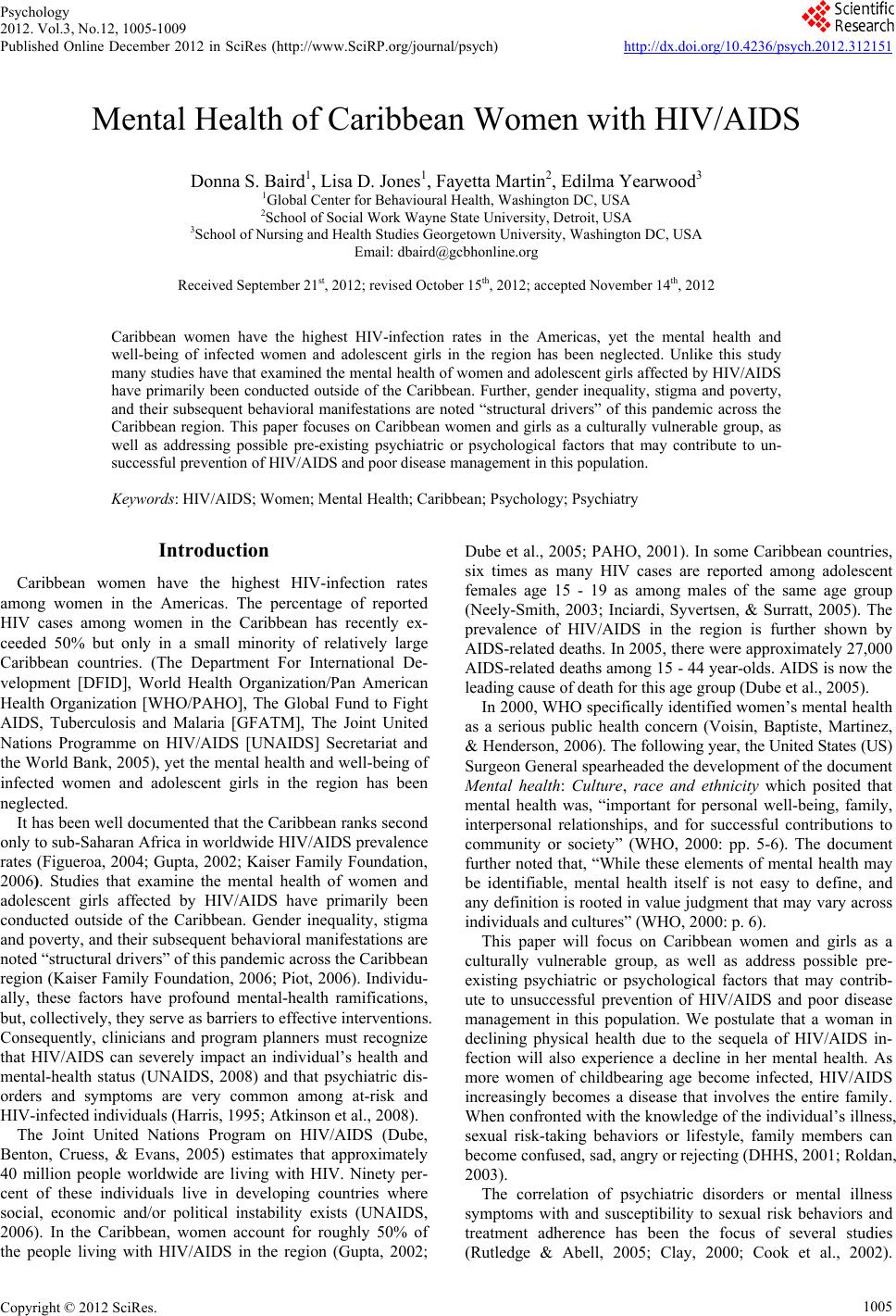 Psychology 2012. Vol.3, No.12, 1005-1009 Published Online December 2012 in SciRes (http://www.SciRP.org/journal/psych) http://dx.doi.org/10.4236/psych.2012.312151 Copyright © 2012 SciRes. 1005 Mental Health of Caribbean Women with HIV/AIDS Donna S. Baird1, Lisa D. Jones1, Fayetta Martin2, Edilma Yearwood3 1Global Center for Behavi o ural Health, Washington DC, USA 2School of Social Work W ay ne State University, Detr o i t, USA 3School of Nursing and H ea l t h S tu d i es G eo rgetown University, Washington DC, USA Email: dbaird@gcbhonline.org Received September 21st, 2012; revised October 15th, 2012; accepted No v e mber 14th, 2012 Caribbean women have the highest HIV-infection rates in the Americas, yet the mental health and well-being of infected women and adolescent girls in the region has been neglected. Unlike this study many studies have that examined the mental health of women and adolescent girls affected by HIV/AIDS have primarily been conducted outside of the Caribbean. Further, gender inequality, stigma and poverty, and their subsequent behavioral manifestations are noted “structural drivers” of this pandemic across the Caribbean region. This paper focuses on Caribbean women and girls as a culturally vulnerable group, as well as addressing possible pre-existing psychiatric or psychological factors that may contribute to un- successful prevention of HIV/AIDS and poor disease management in this population. Keywords: HIV/AIDS; Women; Mental Health; Caribbean; Psychology; Psychiatry Introduction Caribbean women have the highest HIV-infection rates among women in the Americas. The percentage of reported HIV cases among women in the Caribbean has recently ex- ceeded 50% but only in a small minority of relatively large Caribbean countries. (The Department For International De- velopment [DFID], World Health Organization/Pan American Health Organization [WHO/PAHO], The Global Fund to Fight AIDS, Tuberculosis and Malaria [GFATM], The Joint United Nations Programme on HIV/AIDS [UNAIDS] Secretariat and the World Bank, 2005), yet the mental health and well-being of infected women and adolescent girls in the region has been neglected. It has been well documented that the Caribbean ranks second only to sub-Saharan Africa in worldwide HIV/AIDS prevalence rates (Figueroa, 2004; Gupta, 2002; Kaiser Family Founda tion, 2006). Studies that examine the mental health of women and adolescent girls affected by HIV/AIDS have primarily been conducted outside of the Caribbean. Gender inequality, stigma and poverty, and their subsequent behavioral manifestations are noted “structural drivers” of this pandemic across the Caribbean region (Kaiser Family Foundation, 2006; Piot, 2006). Individu- ally, these factors have profound mental-health ramifications, but, collectively, they serve as barriers to effective interventions. Consequently, clinicians and program planners must recognize that HIV/AIDS can severely impact an individual’s health and mental-health status (UNAIDS, 2008) and that psychiatric dis- orders and symptoms are very common among at-risk and HIV-infected individuals (Harris, 1995; Atkinson et al., 2008). The Joint United Nations Program on HIV/AIDS (Dube, Benton, Cruess, & Evans, 2005) estimates that approximately 40 million people worldwide are living with HIV. Ninety per- cent of these individuals live in developing countries where social, economic and/or political instability exists (UNAIDS, 2006). In the Caribbean, women account for roughly 50% of the people living with HIV/AIDS in the region (Gupta, 2002; Dube et al., 2005; PAHO, 2001). In some Caribbean countries, six times as many HIV cases are reported among adolescent females age 15 - 19 as among males of the same age group (Neely-Smith, 2003; Inciardi, Syvertsen, & Surratt, 2005). The prevalence of HIV/AIDS in the region is further shown by AIDS-related deaths. In 2005, there were approximately 27,000 AIDS-related deaths among 15 - 44 year-olds. AIDS is now the leading cause of death for this age group (Dube et al., 2005) . In 2000, WHO specifically identified women’s mental health as a serious public health concern (Voisin, Baptiste, Martinez, & Henderson, 2006). The following year, the United States (US) Surgeon General spearheaded the development of the document Mental health: Culture, race and ethnicity which posited that mental health was, “important for personal well-being, family, interpersonal relationships, and for successful contributions to community or society” (WHO, 2000: pp. 5-6). The document further noted that, “While these elements of mental health may be identifiable, mental health itself is not easy to define, and any definition is rooted in value judgment that may vary across individuals and cultures” (WHO, 2000: p. 6). This paper will focus on Caribbean women and girls as a culturally vulnerable group, as well as address possible pre- existing psychiatric or psychological factors that may contrib- ute to unsuccessful prevention of HIV/AIDS and poor disease management in this population. We postulate that a woman in declining physical health due to the sequela of HIV/AIDS in- fection will also experience a decline in her mental health. As more women of childbearing age become infected, HIV/AIDS increasingly becomes a disease that involves the entire family. When confronted with the knowledge of the individual’s illness, sexual risk-taking behaviors or lifestyle, family members can become confused, sad, angry or rejecting (DHHS, 2001; Roldan, 2003). The correlation of psychiatric disorders or mental illness symptoms with and susceptibility to sexual risk behaviors and treatment adherence has been the focus of several studies (Rutledge & Abell, 2005; Clay, 2000; Cook et al., 2002). 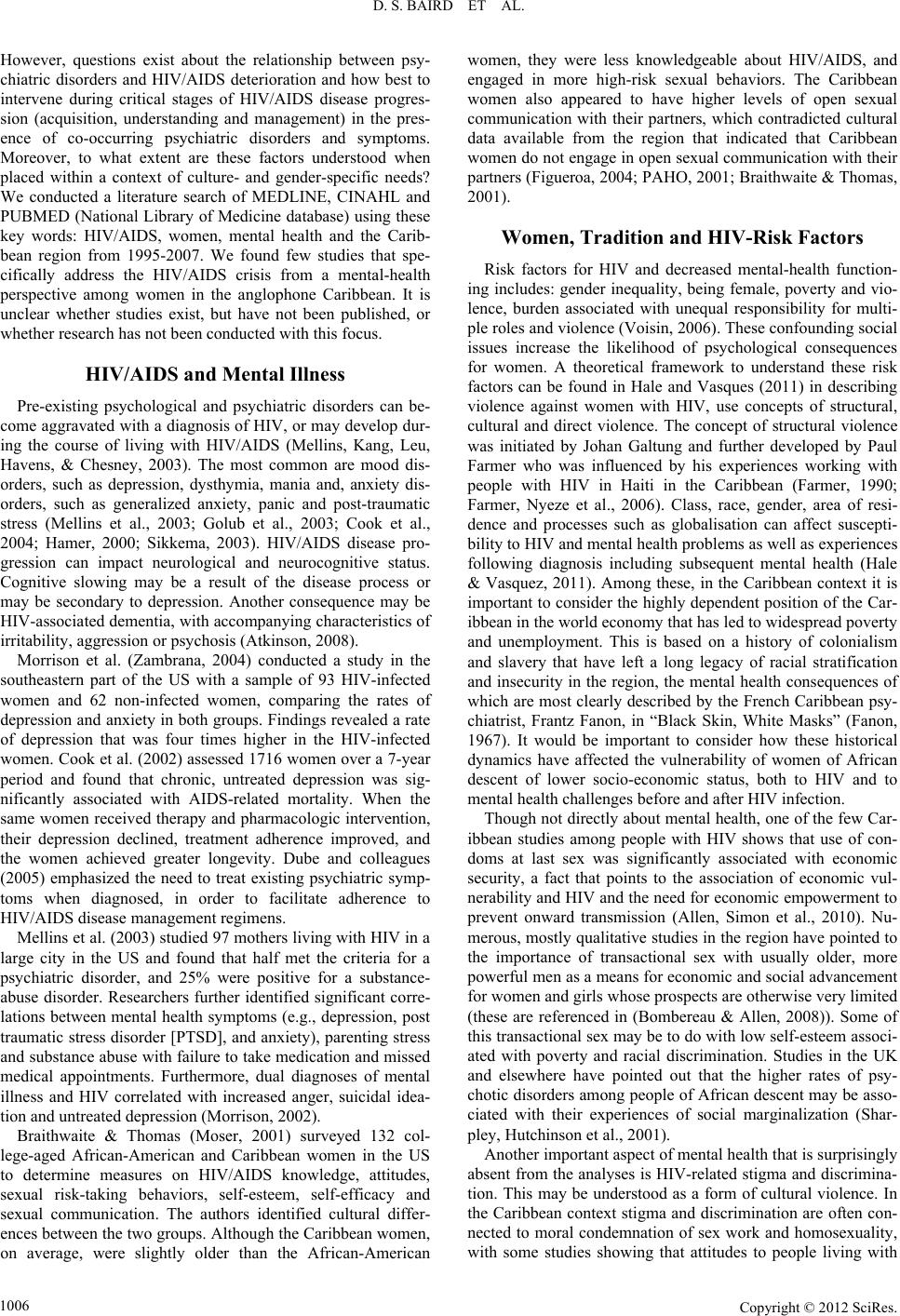 D. S. BAIRD ET AL. However, questions exist about the relationship between psy- chiatric disorders and HIV/AIDS deterioration and how best to intervene during critical stages of HIV/AIDS disease progres- sion (acquisition, understanding and management) in the pres- ence of co-occurring psychiatric disorders and symptoms. Moreover, to what extent are these factors understood when placed within a context of culture- and gender-specific needs? We conducted a literature search of MEDLINE, CINAHL and PUBMED (National Li brary of Medici ne database) using th ese key words: HIV/AIDS, women, mental health and the Carib- bean region from 1995-2007. We found few studies that spe- cifically address the HIV/AIDS crisis from a mental-health perspective among women in the anglophone Caribbean. It is unclear whether studies exist, but have not been published, or whether research has not been conducted with this focus. HIV/AIDS and Mental Illness Pre-existing psychological and psychiatric disorders can be- come aggravated with a diagnosis of HIV, or may develop dur- ing the course of living with HIV/AIDS (Mellins, Kang, Leu, Havens, & Chesney, 2003). The most common are mood dis- orders, such as depression, dysthymia, mania and, anxiety dis- orders, such as generalized anxiety, panic and post-traumatic stress (Mellins et al., 2003; Golub et al., 2003; Cook et al., 2004; Hamer, 2000; Sikkema, 2003). HIV/AIDS disease pro- gression can impact neurological and neurocognitive status. Cognitive slowing may be a result of the disease process or may be secondary to depression. Another consequence may be HIV-associated dementia, with accompanying characteristics of irritability, aggression or psychosis (Atkinson, 2008). Morrison et al. (Zambrana, 2004) conducted a study in the southeastern part of the US with a sample of 93 HIV-infected women and 62 non-infected women, comparing the rates of depression and anxiety in both groups. Findings revealed a rate of depression that was four times higher in the HIV-infected women. Cook et al. (2002) assessed 1716 women over a 7-year period and found that chronic, untreated depression was sig- nificantly associated with AIDS-related mortality. When the same women received therapy and pharmacologic intervention, their depression declined, treatment adherence improved, and the women achieved greater longevity. Dube and colleagues (2005) emphasized the need to treat existing psychiatric symp- toms when diagnosed, in order to facilitate adherence to HIV/AIDS disease management regimens. Mellins et al. (2003) studied 97 mothers living with HIV in a large city in the US and found that half met the criteria for a psychiatric disorder, and 25% were positive for a substance- abuse disorder. Researchers further identified significant corre- lations between mental health symptoms (e.g., depression, post traumatic stress disorder [PTSD], and a nxiety), pare nting stress and substance abuse with failure to take medication and missed medical appointments. Furthermore, dual diagnoses of mental illness and HIV correlated with increased anger, suicidal idea- tion and untreated depression (Morrison, 2002). Braithwaite & Thomas (Moser, 2001) surveyed 132 col- lege-aged African-American and Caribbean women in the US to determine measures on HIV/AIDS knowledge, attitudes, sexual risk-taking behaviors, self-esteem, self-efficacy and sexual communication. The authors identified cultural differ- ences between the two groups. Although the Caribbean women, on average, were slightly older than the African-American women, they were less knowledgeable about HIV/AIDS, and engaged in more high-risk sexual behaviors. The Caribbean women also appeared to have higher levels of open sexual communication with their partners, which contradicted cultural data available from the region that indicated that Caribbean women do not engage in open sexual communication with their partners (Figueroa, 2004; PAHO, 2001; Braithwaite & Thomas, 2001). Women, Tradition and HIV-Risk Factors Risk factors for HIV and decreased mental-health function- ing includes: gender inequality, being female, poverty and vio- lence, burden associated with unequal responsibility for multi- ple roles and violence (Voisin, 2006). These confounding social issues increase the likelihood of psychological consequences for women. A theoretical framework to understand these risk factors can be found in Hale and Vasques (2011) in describing violence against women with HIV, use concepts of structural, cultural and direct violence. The concept of structural violence was initiated by Johan Galtung and further developed by Paul Farmer who was influenced by his experiences working with people with HIV in Haiti in the Caribbean (Farmer, 1990; Farmer, Nyeze et al., 2006). Class, race, gender, area of resi- dence and processes such as globalisation can affect suscepti- bility to HIV and mental health problems as well as experiences following diagnosis including subsequent mental health (Hale & Vasquez, 2011). Among these, in the Caribbean context it is important to consider the highly dependent position of the Car- ibbean in the world economy that has led to widespread poverty and unemployment. This is based on a history of colonialism and slavery that have left a long legacy of racial stratification and insecurity in the region, the mental health consequences of which are most clearly described by the French Caribbean psy- chiatrist, Frantz Fanon, in “Black Skin, White Masks” (Fanon, 1967). It would be important to consider how these historical dynamics have affected the vulnerability of women of African descent of lower socio-economic status, both to HIV and to mental health challenges before and after HIV infection. Though not directly about mental health, one of the few Car- ibbean studies among people with HIV shows that use of con- doms at last sex was significantly associated with economic security, a fact that points to the association of economic vul- nerability and HIV and the need for economic empowerment to prevent onward transmission (Allen, Simon et al., 2010). Nu- merous, mostly qualitative studies in the region have pointed to the importance of transactional sex with usually older, more powerful men as a means for economic and social advancement for women and girls whose prospects are otherwise very limited (these are referenced in (Bombereau & Allen, 2008)). Some of this transactional sex may be to do with low self-esteem associ- ated with poverty and racial discrimination. Studies in the UK and elsewhere have pointed out that the higher rates of psy- chotic disorders among people of African descent may be asso- ciated with their experiences of social marginalization (Shar- pley, Hutchinson et al., 2001). Another important aspect of mental health that is surprisingly absent from the analyses is HIV-related stigma and discrimina- tion. This may be understood as a form of cultural violence. In the Caribbean context stigma and discrimination are often con- nected to moral condemnation of sex work and homosexuality, with some studies showing that attitudes to people living with Copyright © 2012 SciRes. 1006 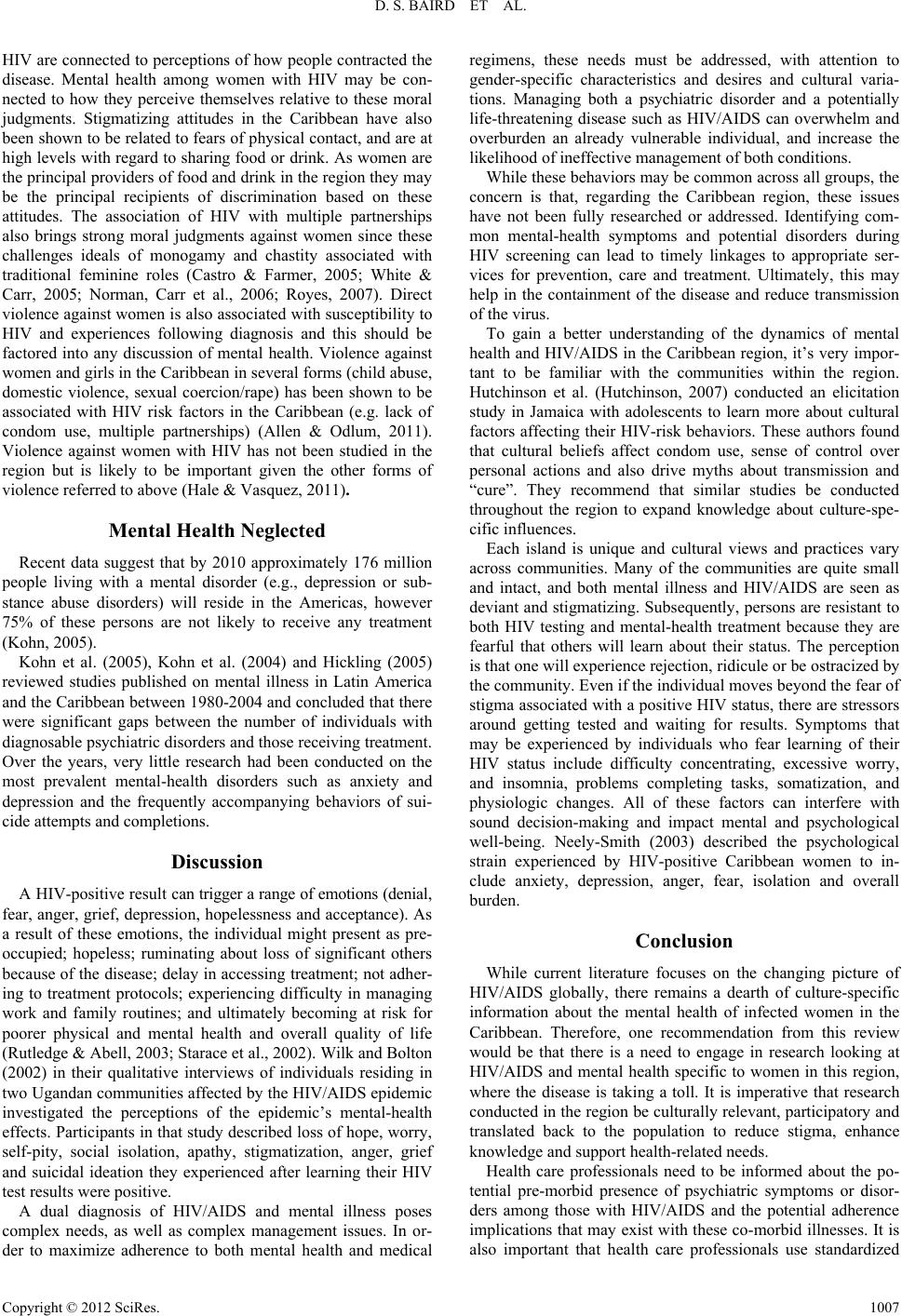 D. S. BAIRD ET AL. HIV are connected to perceptions of how people contracted the disease. Mental health among women with HIV may be con- nected to how they perceive themselves relative to these moral judgments. Stigmatizing attitudes in the Caribbean have also been shown to be related to fears of physical contact, and are at high levels with regard to sharing food or drink. As women are the principal providers of food and drink in the region they may be the principal recipients of discrimination based on these attitudes. The association of HIV with multiple partnerships also brings strong moral judgments against women since these challenges ideals of monogamy and chastity associated with traditional feminine roles (Castro & Farmer, 2005; White & Carr, 2005; Norman, Carr et al., 2006; Royes, 2007). Direct violence against women is also associated with susceptibility to HIV and experiences following diagnosis and this should be factored into any discussion of mental health. Violence against women and girls in the Caribbean in several forms (child abuse, domestic violence, sexual coercion/rape) has been shown to be associated with HIV risk factors in the Caribbean (e.g. lack of condom use, multiple partnerships) (Allen & Odlum, 2011). Violence against women with HIV has not been studied in the region but is likely to be important given the other forms of violence referred to above (Hale & Vasquez, 2011). Mental Health Neglected Recent data suggest that by 2010 approximately 176 million people living with a mental disorder (e.g., depression or sub- stance abuse disorders) will reside in the Americas, however 75% of these persons are not likely to receive any treatment (Kohn, 2005). Kohn et al. (2005), Kohn et al. (2004) and Hickling (2005) reviewed studies published on mental illness in Latin America and the Caribbean between 1980-2004 and concluded that there were significant gaps between the number of individuals with diagnosable psychiatric disorders and those receiving treatment. Over the years, very little research had been conducted on the most prevalent mental-health disorders such as anxiety and depression and the frequently accompanying behaviors of sui- cide attempts and completions. Discussion A HIV-positive result can trigger a range of emotions (denial, fear, anger, grief, depression, hopelessness and acceptance). As a result of these emotions, the individual might present as pre- occupied; hopeless; ruminating about loss of significant others because of the disease; delay in accessing treatment; not adher- ing to treatment protocols; experiencing difficulty in managing work and family routines; and ultimately becoming at risk for poorer physical and mental health and overall quality of life (Rutledge & Abell, 2003; Starace et al., 2002). Wilk and Bolton (2002) in their qualitative interviews of individuals residing in two Ugandan communities affected by the HIV/AIDS epidemic investigated the perceptions of the epidemic’s mental-health effects. Participants in that study described loss of hope, worry, self-pity, social isolation, apathy, stigmatization, anger, grief and suicidal ideation they experienced after learning their HIV test results were positive. A dual diagnosis of HIV/AIDS and mental illness poses complex needs, as well as complex management issues. In or- der to maximize adherence to both mental health and medical regimens, these needs must be addressed, with attention to gender-specific characteristics and desires and cultural varia- tions. Managing both a psychiatric disorder and a potentially life-threatening disease such as HIV/AIDS can overwhelm and overburden an already vulnerable individual, and increase the likelihood of ineffective management of both conditions. While these behaviors may be common across all groups, the concern is that, regarding the Caribbean region, these issues have not been fully researched or addressed. Identifying com- mon mental-health symptoms and potential disorders during HIV screening can lead to timely linkages to appropriate ser- vices for prevention, care and treatment. Ultimately, this may help in the containment of the disease and reduce transmission of the virus. To gain a better understanding of the dynamics of mental health and HIV/AIDS in the Caribbean region, it’s very impor- tant to be familiar with the communities within the region. Hutchinson et al. (Hutchinson, 2007) conducted an elicitation study in Jamaica with adolescents to learn more about cultural factors affecting their HIV-risk behaviors. These authors found that cultural beliefs affect condom use, sense of control over personal actions and also drive myths about transmission and “cure”. They recommend that similar studies be conducted throughout the region to expand knowledge about culture-spe- cific influences. Each island is unique and cultural views and practices vary across communities. Many of the communities are quite small and intact, and both mental illness and HIV/AIDS are seen as deviant and stigmatizing. Subsequently, persons are resistant to both HIV testing and mental-health treatment because they are fearful that others will learn about their status. The perception is that one will experience rejection, ridicule or be ostracized by the community. Even if the individual moves beyond the fear of stigma associated with a positive HIV status, there are stressors around getting tested and waiting for results. Symptoms that may be experienced by individuals who fear learning of their HIV status include difficulty concentrating, excessive worry, and insomnia, problems completing tasks, somatization, and physiologic changes. All of these factors can interfere with sound decision-making and impact mental and psychological well-being. Neely-Smith (2003) described the psychological strain experienced by HIV-positive Caribbean women to in- clude anxiety, depression, anger, fear, isolation and overall burden. Conclusion While current literature focuses on the changing picture of HIV/AIDS globally, there remains a dearth of culture-specific information about the mental health of infected women in the Caribbean. Therefore, one recommendation from this review would be that there is a need to engage in research looking at HIV/AIDS and mental health specific to women in this region, where the disease is taking a toll. It is imperative that research conducted in the region be culturally relevant, participatory and translated back to the population to reduce stigma, enhance knowledge and support health-related needs. Health care professionals need to be informed about the po- tential pre-morbid presence of psychiatric symptoms or disor- ders among those with HIV/AIDS and the potential adherence implications that may exist with these co-morbid illnesses. It is also important that health care professionals use standardized Copyright © 2012 SciRes. 1007 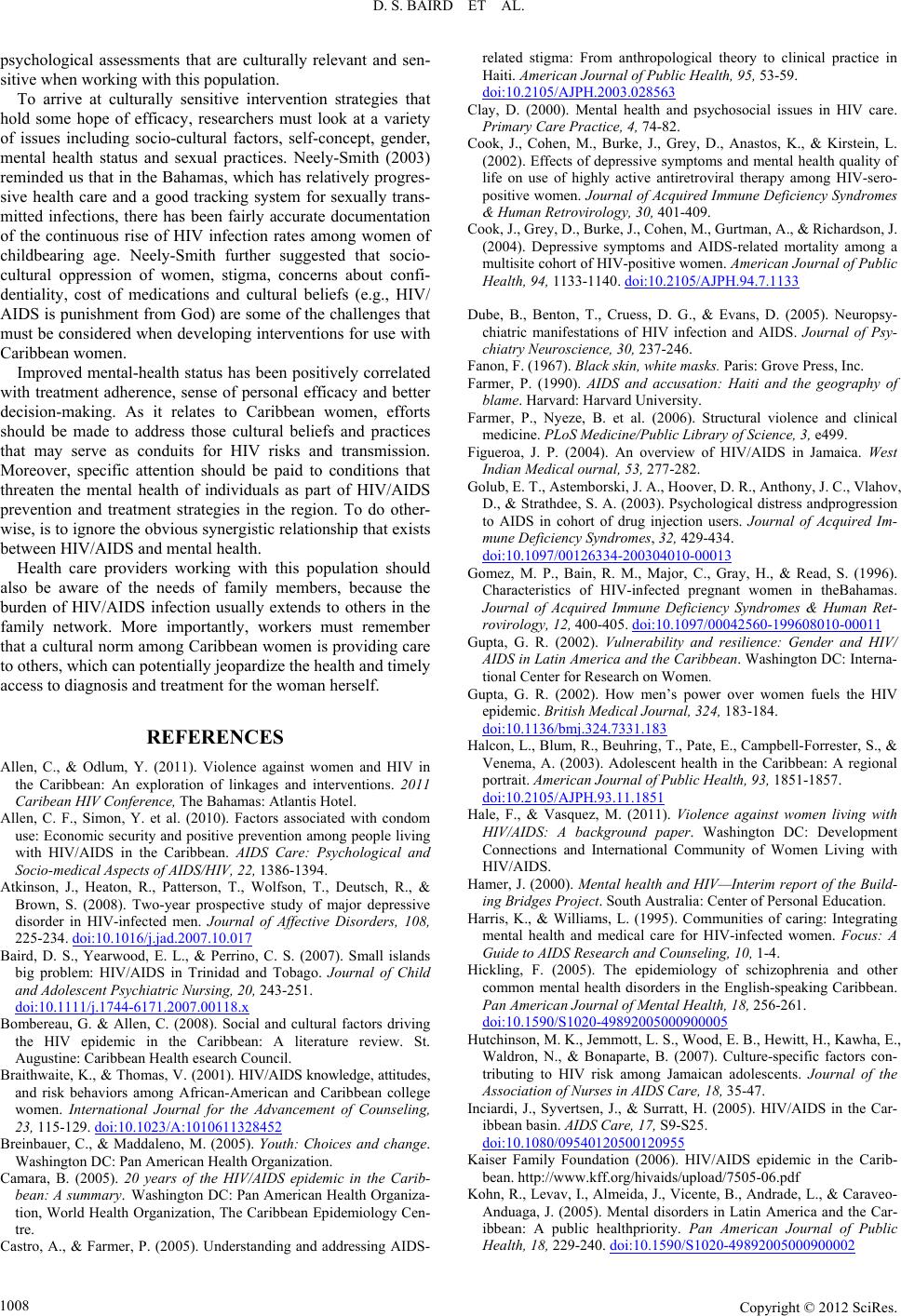 D. S. BAIRD ET AL. psychological assessments that are culturally relevant and sen- sitive when working with this population. To arrive at culturally sensitive intervention strategies that hold some hope of efficacy, researchers must look at a variety of issues including socio-cultural factors, self-concept, gender, mental health status and sexual practices. Neely-Smith (2003) reminded us that in the Bahamas, which has relatively progres- sive health care and a good tracking system for sexually trans- mitted infections, there has been fairly accurate documentation of the continuous rise of HIV infection rates among women of childbearing age. Neely-Smith further suggested that socio- cultural oppression of women, stigma, concerns about confi- dentiality, cost of medications and cultural beliefs (e.g., HIV/ AIDS is punishment from God) are some of the challenges that must be considered when developing interventions for use with Caribbean women. Improved mental-health status has been positively correlated with treatment adherence, sense of personal efficacy and better decision-making. As it relates to Caribbean women, efforts should be made to address those cultural beliefs and practices that may serve as conduits for HIV risks and transmission. Moreover, specific attention should be paid to conditions that threaten the mental health of individuals as part of HIV/AIDS prevention and treatment strategies in the region. To do other- wise, is to ignore the obvious synergistic relationship that exists between HIV/AIDS and mental health. Health care providers working with this population should also be aware of the needs of family members, because the burden of HIV/AIDS infection usually extends to others in the family network. More importantly, workers must remember that a cultural norm among Caribbean women is providing care to others, which can potentially jeopardize the health and timely access to diagnosis and treatment for the woman herself. REFERENCES Allen, C., & Odlum, Y. (2011). Violence against women and HIV in the Caribbean: An exploration of linkages and interventions. 2011 Caribean HIV Conference, The Bahamas: Atlantis Hotel. Allen, C. F., Simon, Y. et al. (2010). Factors associated with condom use: Economic security and positive prevention among people living with HIV/AIDS in the Caribbean. AIDS Care: Psychological and Socio-medical Aspects of AIDS/HIV, 22, 1386-1394. Atkinson, J., Heaton, R., Patterson, T., Wolfson, T., Deutsch, R., & Brown, S. (2008). Two-year prospective study of major depressive disorder in HIV-infected men. Journal of Affective Disorders, 108, 225-234. doi:10.1016/j.jad.2007.10.017 Baird, D. S., Yearwood, E. L., & Perrino, C. S. (2007). Small islands big problem: HIV/AIDS in Trinidad and Tobago. Journal of Child and Adolescent Psychiatric Nur s i ng , 20, 243-251. doi:10.1111/j.1744-6171.2007.00118.x Bombereau, G. & Allen, C. (2008). Social and cultural factors driving the HIV epidemic in the Caribbean: A literature review. St. Augustine: Caribbean Health esearch Council. Braithwaite, K., & Thomas, V. (2001). HIV/AIDS knowledge, attitudes, and risk behaviors among African-American and Caribbean college women. International Journal for the Advancement of Counseling, 23, 115-129. doi:10.1023/A:1010611328452 Breinbauer, C., & Maddaleno, M. (2005). Youth: Choices and change. Washington DC: Pan American Health Organization. Camara, B. (2005). 20 years of the HIV/AIDS epidemic in the Carib- bean: A summary. Washington DC: Pan American Health Organiza- tion, World Health Organization, The Caribbean Epidemiology Cen- tre. Castro, A., & Farmer, P. (2005). Understanding and addressing AIDS- related stigma: From anthropological theory to clinical practice in Haiti. American Journal of Public Health, 95, 53-59. doi:10.2105/AJPH.2003.028563 Clay, D. (2000). Mental health and psychosocial issues in HIV care. Primary Care Practice, 4, 74-82. Cook, J., Cohen, M., Burke, J., Grey, D., Anastos, K., & Kirstein, L. (2002). Effects of depressive symptoms and mental health quality of life on use of highly active antiretroviral therapy among HIV-sero- positive women. Journal of Acquired Immune Deficiency Syndromes & Human Retrovirology, 30, 401-409. Cook, J., Grey, D., Burke, J., Cohen, M., Gurtman, A., & Richardson, J. (2004). Depressive symptoms and AIDS-related mortality among a multisite cohort of HIV-positive women. American Journal of Public Health, 94, 1133-1140. doi:10.2105/AJPH.94.7.1133 Dube, B., Benton, T., Cruess, D. G., & Evans, D. (2005). Neuropsy- chiatric manifestations of HIV infection and AIDS. Journal of Psy- chiatry Neuroscience, 30, 237-246. Fanon, F. (1967). Black skin, white masks. Paris: Grove Press, Inc. Farmer, P. (1990). AIDS and accusation: Haiti and the geography of blame. Harvard: Harvard University. Farmer, P., Nyeze, B. et al. (2006). Structural violence and clinical medicine. PLoS Medicine/Public Library of Science, 3, e499. Figueroa, J. P. (2004). An overview of HIV/AIDS in Jamaica. West Indian Medical ournal, 53, 277-282. Golub, E. T., Astem b orski, J. A., Hoover, D. R., Anthony, J. C., Vlahov, D., & Strathdee, S. A. (2003). Psychological distress andprogression to AIDS in cohort of drug injection users. Journal of Acquired Im- mune Deficiency Syndromes, 32, 429-434. doi:10.1097/00126334-200304010-00013 Gomez, M. P., Bain, R. M., Major, C., Gray, H., & Read, S. (1996). Characteristics of HIV-infected pregnant women in theBahamas. Journal of Acquired Immune Deficiency Syndromes & Human Ret- rovirology, 12, 400-405. doi:10.1097/00042560-199608010-00011 Gupta, G. R. (2002). Vulnerability and resilience: Gender and HIV/ AIDS in Latin America and the Caribbean. Washington DC: Interna- tional Center for Research on Women. Gupta, G. R. (2002). How men’s power over women fuels the HIV epidemic. British Medical Journal, 324, 183-184. doi:10.1136/bmj.324.7331.183 Halcon, L., Blum, R., Beuhring, T., Pate, E., Campbell-Fo rrester, S., & Venema, A. (2003). Adolescent health in the Caribbean: A regional portrait. American Journal of Public Health, 93, 1851-1857. doi:10.2105/AJPH.93.11.1851 Hale, F., & Vasquez, M. (2011). Violence against women living with HIV/AIDS: A background paper. Washington DC: Development Connections and International Community of Women Living with HIV/AIDS. Hamer, J. (2000). Mental health and HIV—Interim report of the Build- ing Bridges Project. S o u t h A u s t ralia: Center of Personal Educ a t i o n . Harris, K., & Williams, L. (1995). Communities of caring: Integrating mental health and medical care for HIV-infected women. Focus: A Guide to AIDS Research and Counseling, 10, 1-4. Hickling, F. (2005). The epidemiology of schizophrenia and other common mental health disorders in the English-speaking Caribbean. Pan American Journal of Mental Health, 18, 256-261. doi:10.1590/S1020-49892005000900005 Hutchinson, M. K., Jemmott, L. S., Wood, E. B., Hewitt, H., Kawha, E., Waldron, N., & Bonaparte, B. (2007). Culture-specific factors con- tributing to HIV risk among Jamaican adolescents. Journal of the Association of Nurses in AIDS Ca re, 18, 35-47. Inciardi, J., Syvertsen, J., & Surratt, H. (2005). HIV/AIDS in the Car- ibbean basin. AIDS Care, 17, S9-S25. doi:10.1080/09540120500120955 Kaiser Family Foundation (2006). HIV/AIDS epidemic in the Carib- bean. http://www.kff.org/hivaids/upload/7505-06.pdf Kohn, R., Levav, I., Almeida, J., Vicente, B., Andrade, L., & Caraveo- Anduaga, J. (2005). Mental disorders in Latin America and the Car- ibbean: A public healthpriority. Pan American Journal of Public Health, 18, 229-240. doi:10.1590/S1020-49892005000900002 Copyright © 2012 SciRes. 1008 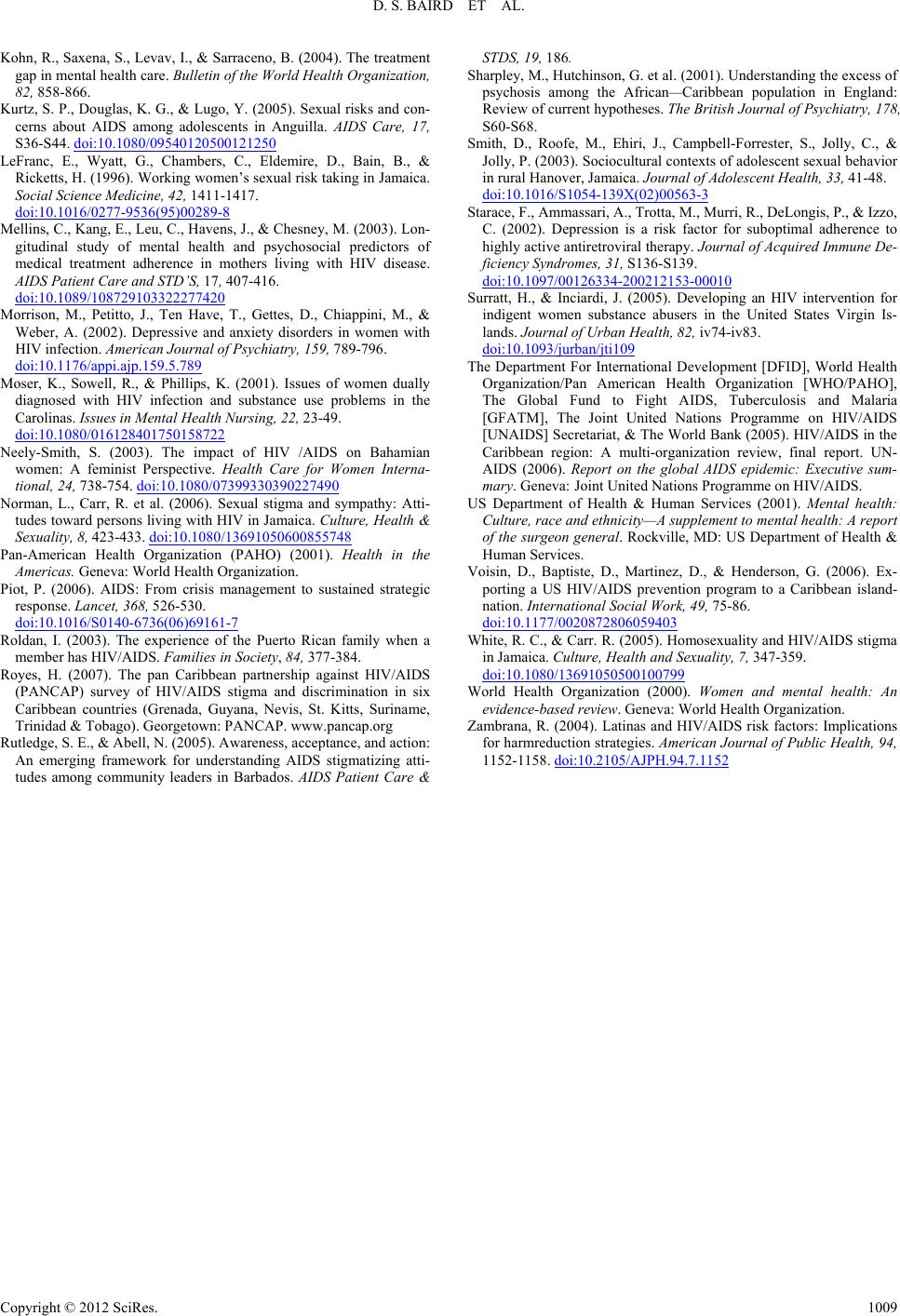 D. S. BAIRD ET AL. Copyright © 2012 SciRes. 1009 Kohn, R., Saxena, S., Levav, I., & Sarraceno, B. (2004). The treatment gap in mental health care. Bulletin of the World Health Organization, 82, 858-866. Kurtz, S. P., Douglas, K. G., & Lugo, Y. (2005). Sexual risks and con- cerns about AIDS among adolescents in Anguilla. AIDS Care, 17, S36-S44. doi:10.1080/09540120500121250 LeFranc, E., Wyatt, G., Chambers, C., Eldemire, D., Bain, B., & Ricketts, H. (1996). Working women’s sexual risk taking in Jamaica. Social Science Medicine, 42, 1411-1417. doi:10.1016/0277-9536(95)00289-8 Mellins, C., Kang, E., Leu, C., Havens, J., & Chesney, M. (2003). Lon- gitudinal study of mental health and psychosocial predictors of medical treatment adherence in mothers living with HIV disease. AIDS Patient Care and STD’S, 17, 407-416. doi:10.1089/108729103322277420 Morrison, M., Petitto, J., Ten Have, T., Gettes, D., Chiappini, M., & Weber, A. (2002). Depressive and anxiety disorders in women with HIV infection. American J our nal of Psychiatry, 159, 789-796. doi:10.1176/appi.ajp.159.5.789 Moser, K., Sowell, R., & Phillips, K. (2001). Issues of women dually diagnosed with HIV infection and substance use problems in the Carolinas. Issues in Mental Health Nursing, 22, 23-49. doi:10.1080/016128401750158722 Neely-Smith, S. (2003). The impact of HIV /AIDS on Bahamian women: A feminist Perspective. Health Care for Women Interna- tional, 24, 738-754. doi:10.1080/07399330390227490 Norman, L., Carr, R. et al. (2006). Sexual stigma and sympathy: Atti- tudes toward persons living with HIV in Jamaica. Culture, Health & Sexuality, 8, 423-433. doi:10.1080/13691050600855748 Pan-American Health Organization (PAHO) (2001). Health in the Americas. Geneva: World Health Organization. Piot, P. (2006). AIDS: From crisis management to sustained strategic response. Lancet, 368, 526-530. doi:10.1016/S0140-6736(06)69161-7 Roldan, I. (2003). The experience of the Puerto Rican family when a member has HIV/AIDS. Families in Society, 84, 377-384. Royes, H. (2007). The pan Caribbean partnership against HIV/AIDS (PANCAP) survey of HIV/AIDS stigma and discrimination in six Caribbean countries (Grenada, Guyana, Nevis, St. Kitts, Suriname, Trinidad & Tobago). G eo rgetown: PANCAP. www.pancap.org Rutledge, S. E., & Abell, N. (2005). Awareness, a c c e p ta n c e , and action: An emerging framework for understanding AIDS stigmatizing atti- tudes among community leaders in Barbados. AIDS Patient Care & STDS, 19, 186. Sharpley, M., Hutchinson, G. et al. (2001). Understanding the excess of psychosis among the African—Caribbean population in England: Review of current hypotheses. The British Journal of Psychiatry, 178, S60-S68. Smith, D., Roofe, M., Ehiri, J., Campbell-Forrester, S., Jolly, C., & Jolly, P. (2003). Sociocultural contexts of adolescent sexual behavior in rural Hanover, Jamaica. J ou r n al of Adolescent Health, 33, 41-48. doi:10.1016/S1054-139X(02)00563-3 Starace, F., Ammassari, A., Trotta, M., Murri, R., DeLongis, P., & Izzo, C. (2002). Depression is a risk factor for suboptimal adherence to highly active antiretroviral therapy. Journal of Acquired Immune De- ficiency Syndromes, 31, S136-S139. doi:10.1097/00126334-200212153-00010 Surratt, H., & Inciardi, J. (2005). Developing an HIV intervention for indigent women substance abusers in the United States Virgin Is- lands. Journal of Urban Health, 82, iv74-iv83. doi:10.1093/jurban/jti109 The Department For International Develop ment [DFID], Wo rld Health Organization/Pan American Health Organization [WHO/PAHO], The Global Fund to Fight AIDS, Tuberculosis and Malaria [GFATM], The Joint United Nations Programme on HIV/AIDS [UNAIDS] Secretariat, & The World Bank (2005). HIV/AIDS in the Caribbean region: A multi-organization review, final report. UN- AIDS (2006). Report on the global AIDS epidemic: Executive sum- mary. Geneva: Joint United Nati ons Programme on HIV/AIDS. US Department of Health & Human Services (2001). Mental health: Culture, race and ethnicity—A supplement to mental health: A report of the surgeon general. Rockville, MD: US Department of Health & Human Services. Voisin, D., Baptiste, D., Martinez, D., & Henderson, G. (2006). Ex- porting a US HIV/AIDS prevention program to a Caribbean island- nation. International Social Work, 49, 75-86. doi:10.1177/0020872806059403 White, R. C., & Carr. R. (2005). Homosexuality and HIV/AIDS stigma in Jamaica. Culture, Health and Sexuality, 7, 347-359. doi:10.1080/13691050500100799 World Health Organization (2000). Women and mental health: An evidence-based review. Geneva: World Health Orga nizati on. Zambrana, R. (2004). Latinas and HIV/AIDS risk factors: Implications for harmreduction strategies. American Journal of Public Health, 94, 1152-1158. doi:10.2105/AJPH.94.7.1152
|